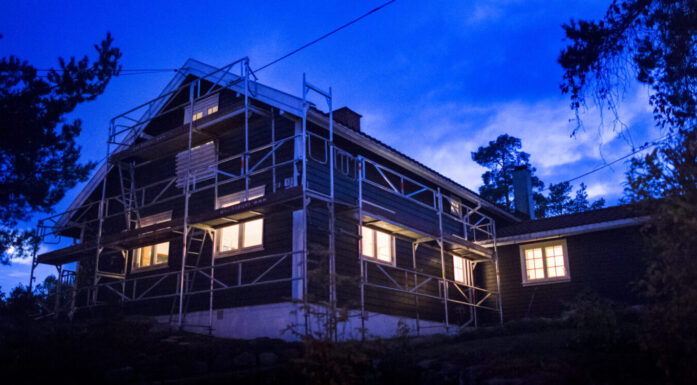An artificial lava for sealing oil and gas wells has passed its lab tests
Norwegian oil and gas companies are now plugging and abandoning production wells using an artificial ‘lava’. So far, the results have been excellent. Recent laboratory results indicate that the same method can be used to seal subsurface CO2 storage reservoirs.
Many oil and gas wells on the Norwegian shelf have now reached the point at which production is no longer cost-effective. But before they are abandoned, they have to be sealed, or plugged, in order to prevent any remaining oil and gas from leaking out. The current practice is to fill the casing in such wells with a long cement plug.
However, in countries such as Canada, which has more than a hundred times more wells than Norway, leakages have arisen in many places, both in and around the cement plugs. The phenomenon has also been observed in some plugged and abandoned wells in the North Sea.
The Norwegian well services company Interwell has recently developed a promising alternative technology that effectively recreates the original geological conditions – sealing the wells on nature’s terms. The method involves the use of intense heat and molten metal.
Artificial lava
When oil and gas wells are finally abandoned, there may still be large volumes of hydrocarbons, including gas, left in the subsurface. If such wells are not adequately sealed, the gas may leak into the atmosphere.
The gas involved is mostly methane, which can capture more than 25 per cent more heat per molecule than CO2. The sealing of production wells, which is mandatory in Norway and other countries, will thus contribute towards reducing global warming.
On the basis in particular of the Canadian experience with current cement plugs, intense research is now being carried out to identify alternative methods and sealing materials, such as modified cements, composites and polymers.
The alternative offered by Interwell involves the use of a metal plug, including a bismuth alloy, that is produced at depth in the well casing. An artificial lava, or magma, is effectively created at depth in the subsurface which melts all the manufactured components and materials. These then solidify to form a permanent barrier that seals the well.

This is what you would see if you could look down into an oil or gas well while it is being sealed using the method developed by the Norwegian well services company Interwell. Molten metals solidify to form a permanent plug. Illustration courtesy of Interwell.
Relevance for subsurface CO2 storage
The method is already being used in Canada, with promising outcomes, and we have been testing the concept in the laboratory at SINTEF, also with good results. One of our conclusions is that the system may also be well suited to sealing abandoned oil and gas wells in reservoirs selected for the future storage of CO2.
The key component of the Interwell concept, called ‘RockSolid’™ is a solid barrier, or plug, consisting of several ‘phases’. The phases are formed in what in technical terms is referred to as a thermite reaction, which involves the ignition of a metal in the presence of the oxide of another metal that is more noble than the first. The oxygen then changes places, or ‘jumps’ from the oxide to the unoxidized metal in a reaction that releases intense heat.
The same type of reaction is used for welding rail tracks. Here, a mixture of iron oxide and aluminium is ignited. The reaction produces liquid iron that binds itself to the steel rail. The aluminium oxide that is formed then peels off as a slag.
Interwell’s plug concept utilises the same principle although, in this case, the iron is replaced by a bismuth alloy. The reaction temperature is more than 3,500°C, which causes both the well casing and the cement surrounding it to melt. The intense reaction creates an elongated plug that completely fills the available space, adapting itself to the irregular shape of the borehole.
- You might also like: New concrete from old buildings
Penetrates a long way

Diagram of a full-scale test plug cross-section with phase layering produced using the Interwell method. Diagram courtesy of Interwell
In the molten state, the phases separate due to their different densities so the solidified plug ends up being made up of a number of vertical layers, with a bismuth alloy at the base, the melted steel casing in the centre, and a residue slag and minerals at the top.
The high temperature makes the molten mass very fluid, enabling it to penetrate deeply into any fractures in the surrounding geological formations and preventing any gas from leaking away.
The alloy expands when it solidifies. It also has a low melting point that enables it to remain liquid and penetrate the fissures and fractures in the formation a long time after the other phases have solidified. All this contributes to reinforcing the seal.
Excellent test results
At SINTEF, we have been studying the extent to which the barrier plug is resistant to its enclosing environment in an ‘infinity perspective’. We have carried this out by performing the following tests:
- The simulation of downhole conditions including elevated temperatures, pressures and the presence of CO2, H2S and chlorides (compounds that can cause corrosion). Our findings have shown that these factors have no effect on the bismuth alloy barrier layer. The steel layer did incur some corrosion. However, at some point this process will stagnate. Besides, the steel layer has no sealing function. Its main purpose is to act as a mechanical locking mechanism.
- The imposition of mechanical loads on the bismuth alloy and steel layers with the aim of simulating the residual tensile stresses that arise after cooling and any settling of the rock formations. We identified no environmentally-induced fractures in the bismuth alloy or the steel phase that might compromise their sealing properties or structural integrity, respectively.
- An examination of whether the contact between the bismuth alloy and the steel phase may lead to galvanic corrosion and hydrogen absorption with associated brittleness. However, no brittleness was detected.
- The use of scanning electron microscopy (SEM) to confirm areas where we observed that the bismuth alloy was homogeneous, with little evidence of contamination. This is a major advantage with a view to sealing.
- Conclusion: Neither the bismuth alloy nor the steel phase in the barrier plug showed any signs that downhole conditions will cause degradation that can compromise its intended function in an ‘infinity perspective’.
Already in use in Canada
The Interwell barrier plug can be established using lightweight equipment, without the use of special rigs or lengthy and costly cementing processes.
The technology is already in use in Canada, where many barrier plugs of this type have been installed. The method has been approved by industry operators and the Canadian authorities as an effective method for the permanent sealing of deep well leakages.
Our analyses also show that the system may be ideal for the sealing of oil and gas wells in reservoirs selected for the future storage of CO2. Preliminary assessments for qualification of the method for this purpose have already been carried out.
In summary, when it comes to the important work of sealing abandoned production wells in CO2 storage reservoirs on the continental shelf, the smart thing to do is to play by nature’s rules.
This article was first published in the technology magazine Teknisk Ukeblad on 31 January 2023, and is reproduced here with the permission of the magazine.





